Pirate attacks database, modern
pirates, pirates, pirates of the 21th Century, pirate attacks,
pirates
The Serious Problem of Modern High
Seas Piracy
-
Presentation At Port of Chicago
- November 2000
November
2005 Update
A Courtesy Reference
from .........
The Law
Offices of

Countryman &
McDaniel
The
Logistics - Customs Broker Attorneys
International Trade
Consultants
"Overlooking Runway 25
- Right, at Los Angeles International Airport"

MODERN HIGH
SEAS PIRACY
20 November 2000
Presentation
And November 2005
Update
To The Propeller
Club of The United States At Port of Chicago
With Customary
Tutorials For Your Use
The History
Channel -
"Return
of The Pirates"
featuring host Michael McDaniel of
Countryman
& McDaniel
- U.S. National
Television Prime Time Premier 8pm to 10pm - Sunday, July 16
2006
-
Stopping the next 911?
__
MODERN
HIGH SEAS PIRACY
The Presentation OF MICHAEL S. McDaniel,
ESQ.
Before The
PROPELLER CLUB OF THE UNITED
STATES
At The
Port of Chicago
NOVEMBER 20,
2000
November 2005
Update
__
INDEX TO MODERN HIGH
SEAS PIRACY
1.
INTRODUCTION
2.
THE
FALL & RISE OF PIRACY
The
Ancient Fall
The
Modern Rise
Incredible
Increase For Year 2000
3.
WHAT
IS PIRACY?
4.
WHERE
IS MODERN PIRACY?
5.
TYPES
OF MODERN PIRATES
6.
TYPES
OF MODERN PIRATE ATTACKS
7.
THE
PHANTOM SHIP
8.
AWAITING
ENVIRONMENTAL DISASTER
9.
THERE'S
MORE PIRACY THAN YOU THINK
- the problem of
under-reporting
10.
ANTI-PIRACY
EFFORTS
11.
PRIVATE
NAVIES
12.
THE
INT"L MARITIME BUREAU
- on the front line
13.
WHY
NOT ARM THE MERCHANT SHIPS?
14.
CONCLUSION
15.
Daily Int'l Vessel Casualties & Pirate Atttack Daily
Reports
16.
2005 Modern
High Seas Piracy Update
Pirate
Study Guides >>

Study
Guide
>>
Anti-Shipping
Activity Warning Messages:
Sea piracy jumped 57% worldwide in year 2000
with Indonesian waters recording the highest number of
attacks. (Source:IMB)
In
1999
In
1998
In
1997
In
1996
In
1995
In
1994
In
1993
In
1992
In
1991
In
1990
In
1989
In
1988
In
1987
In
1986
In
1985
Study
Guide
>>
Piracy
Reports
For 1999 ....Piracy
Reports For 2000
......Piracy
Reports For 2001
Study
Guide
>>
International Maritime Bureau
IMB
Piracy
Reporting Center
-
THE official source
Weekly
Piracy
Reports of IMB
Organizational
Chart For Anti-Piracy
Reporting
Study
Guide
>>
24
Hour Int'l Vessel Casualties & Pirates
Database
-- The
Daily Casualty Reports
Modern
Pirates
Resources
Worldwide
Piracy
Reports
Tale
of A Modern Pirate Gang
Piracy
Research
Pirates
& Privateers
INTRODUCTION
November 20 2000 at Port of Chicago --
Good afternoon. I appreciate this opportunity to be here at the Port
of Chicago to discuss a very important topic for our industry
-
- the little known
facts - of a very big international problem &emdash;
Modern High Seas
Piracy.
The author Joseph Conrad referred to them as
"those colorful
Vagabonds of the sea." Generations of
children have hidden under their covers with a flashlight to read
about adventures on "Treasure Island" &endash; and who could forget
those lustily singing and jolly characters at Disney's "Pirates of
the Carribean?"
You have been trained to believe in
PIRATES
as part of the wild wind of adventure --
Here is the deadly modern reality
--
15 merchants vessels
highjacked
by pirates;
138 merchant vessels
boarded
by pirates;
11 merchant vessels
fired
upon by
pirates
35 merchant crew members
badly
injured;
Over 400 merchant crew members
taken
hostage by pirates;
and
Over 75 merchant crew members
murdered
in cold blood.
But those figures are for 1998.
Murder, rape,
mutilation, robbery and a host of
other crimes by depraved, blood thirsty pirates without pity only
got worse in 1999 and 2000. This year alone the increase
may be as much as 60%.
April 15 2001 Special Note: Sea piracy
jumped 57% worldwide in Year 2000 with Indonesian waters recording
the highest number of attacks. (Source:IMB)
(Slide 1 - to be added )
Gone from the pirate's shoulder is that
comical parrot &endash; to make room for a rocket propelled grenade
launcher, an A.K.A.-47, an M-16 rifle or an Uzi machine
gun.
Leaving Mr. Joseph Conrad in his past, a
definition of the modern pirate should properly be:
"Hostis
Humani Generis" - -
"Enemy
of the human race."
To
Top of Pirate Presentation
The
Fall & Rise of Piracy
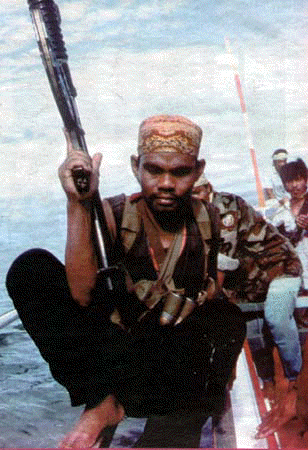
But I thought pirates were gone 200
years ago, you say! -- Indeed, for a time this was
true.
Robert Louis Stevenson's type of piracy in the
16th & 17th centuries fell into decline for four primary
reasons:
The Ancient
Fall
1. Technology: The increased size &
speed of merchant vessels in the 18th & 19th centuries severely
disadvantaged pursuing pirates;
2. Increased Naval Presence: The 19th
& 20th centuries saw an ever increasing level of international
Naval patrols along most ocean highways & particularly in support
of colonial networks;
3. Increased Government Administration:
The 19th & 20th Centuries were marked by the regular
administration of most islands and land areas by colonies or nations
which took a direct interest in protecting their merchant
fleets.
4. Uniform Regulation: There was a
general recognition of piracy as a serious international offense
which would not be tolerated by countries determined to protect their
national fleets and able to do so.
The Modern
Rise
Following World War II however, these four
self enforcing barriers to high seas piracy began to erode. The four
factors have now actually begun to encourage the activity.
Let's see how these same four factors have
reversed themselves in recent years:
1. Technology: The protection once
afforded to merchant vessels by their modern size and speed is now
offset by further technical advances which have reduced crew size, as
well as a vessel's ability to defend itself. On the other side of the
coin, there has been a bumper crop of technological advances which
improve the pirate chief's weapons of speed, shock, surprise, fire
power and rapid escape.
2. Reduced Naval Presence: The trend is
for smaller world Navies. Dramatically decreased international ocean
patrols have left merchant vessels virtually unprotected on the sea
frontier.
3. Disrupted Governmental
Administration: Decisions by former colonies not to maintain ties
with their home countries, and the financial inability of some
governments to afford effective Naval assets &endash; are factors
which have simply encouraged pirate attacks.
4. Lack of Regulation: In some quarters
there has been erosion of the view that piracy is a serious
international crime, or even a crime of which anyone should take
notice. With most of the world's 64 million gross tonnage fleet under
flags of convenience such as Panama, Honduras and Liberia, there is
no political will to smash high seas piracy.
Flags of convenience nations have neither the
interest nor the ability to mount an effective deterent. Indeed
neither Honduras nor Panama are feared as major naval powers!
Officials of the International Maritime Bureau
in London call the present involvement by world governments against
piracy to be "in
shambles."
To put it in another way, piracy is on the
rise because there's lots of valuable stuff out there to steal
&endash; but no one to stop them. This may not be politically
correct, but where pirates are concerned, there are certain
advantages to a world under arms which does not look to the United
States to be its lone policeman -- as out world is today.
In fact, it is probably most accurate to think
of the recent rise in High Seas Piracy as a true "Peace
Dividend" which was conferred on our
industry by the ending of the Cold War. The once proud and
global Russian Navy is now practically non existent at a time
when the Naval presence of the U.S. and Great Britain has been
reduced by about 50%.
Indeed, the number of international pirate
attacks has risen in direct inverse proportion to decreases in the
international Naval presence.
This situation becomes even more confused and
dangerous when you consider the number of countries which have
extended their territorial waters out to 200 nautical miles, but
failed to plan for a corresponding maritime patrol ability.
Increddible
Increase In Year 2000
I have already told you about the 202 pirates
incidents from 1998. These were followed in 1999 by about 309
incidents. This year through September alone, there were 337 attacks
by some estimates. But even these numbers don't include another 3,000
incidents involving yachts and small boats. The problem is serious,
but one that for some reason you will never hear about on the evening
news.
(Slide 2 - to be added )
Piracy and marine fraud is a US$16 billion
industry on the rise. If piracy were a stock, it would have
traded well above Mircosoft on world exchanges for the Year 2000. Who
could have imagined that a 17th Century concept could out pace
"techno-growth."
To
Top of Pirate Presentation
WHAT IS
PIRACY?
So piracy is back and it's bad -- but exactly
what is it? According to the International
Maritime Bureau the
definition is:
"Piracy is the act of boarding
any vessel with an intent to commit theft or any other crime, and
with an intent or capacity to use force in furtherance of that
act."
In order to distinguish it from simple
highjacking, a piracy crime requires that two vessels are involved in
the incident. The second requirement is that the crime has been
undertaken for private, not political purposes. These can be
important considerations when determining coverage under a policy of
marine cargo insurance.
For example, in one famous British case from
years ago, the marine policy was "warranted free of capture,
seizure and detention...piracy excepted." All was well for
payment of the claim, until it was discovered that the so-called
"Pirates" who took the assured vessel had actually been attempting to
overthrow the Bolivian government! Seizure of the vessel had been a
political act.
Political act
>>
no pirate. No pirate >>
no insurance coverage.*
[*Modern
policies avoid this problem through use of the war risk
clause.]
To
Top of Pirate Presentation
WHERE IS
PIRACY?
So where are the international danger areas?
Piracy is often referred to as a "movable
crime" because new hot spots tend to pop up all the time while other
locations return to relative peace.
One thing for sure, for some time now the 2
most dangerous areas without peer are on either side of the
Strait of
Malacca, between Malaysia on one side
and the Indonesian Island of Sumatra on the other. This is the main
ocean highway from Asia to Europe, used by 50,000 ships per year.
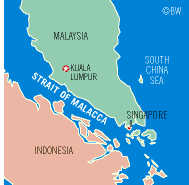
The Number 3 area of concern is
Bangladesh. There is even a "General Warning" now in effect
for pirates in the area of Port Chittagong.
India ranks 4th in the world &endash; where
current government regulations restrict sailing to daylight
operations only due to pirate activity.
Having been in 1st place at times during the
1990s, Brazil remains a particular hotbed of pirate
activity.
1998 Pirate Attacks By
Region
1999 - 2000 Not Much Change By Region To
Present
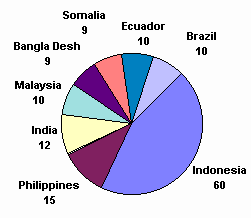
Other areas of concern include:
The Philippines;
The Arabian Peninsula;
The West African Coast;
The Coasts of Venezuela &
Columbia;
The area know as "Mosquito Bay" between
Nicaragua & Jamaica &emdash; and of course that gambling
boat at East Moline, Illinois!*
[*East
Moline is a town west of Chicago on the Mississippi
River]
Pirate Attacks - 1998 - Southeast
Asia
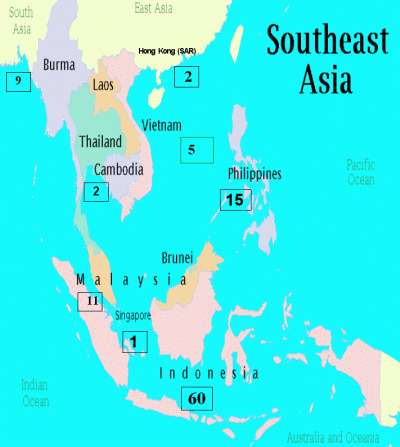
To
Top of Pirate Presentation
TYPES
OF PIRATES
There are generally three categories of
pirates.
The first type of pirate is your standard
issue low-life criminal. These are scum who find it more expedient to
just steal your finger, instead of taking the time to remove your
ring.
The second pirate type is a more sophisticated
organized crime group such as the five gangs thought to control a
significant percentage of piracy in Southeast Asia or one of the
several triads believed to control this crime in China.
The third and perhaps the most troubling type
is the "Semi-Official
Military Pirate," examples of which
have been seen in China, Indonesia & Somalia and elsewhere.
When you're all alone at sea, it is
particularly scary not to know whether that approaching Chinese
Coastguard Patrol Boat is:
(a) The Chinese Coastguard on
official government business, or
(b) A real Chinese Coastguard Patrol
Boat, but freelancing as a pirate ship to earn some extra cash for
the holidays, or
(c) Actual pirates who have merely
painted their vessel to look like one of the real Chinese
Coastguards. Either way, not much can be done except to hold your
breath knowing that an hour later you will either be dead or
alive.
Even if the patrol boat is on official
business, that's no guarantee of safety.
While the practice seems in decline now that
China continues its march toward ascension to the World
Trade Organization, recent years have
seen Chinese patrol boats foray deep into international waters in
search of "customers." When a suitable vessel is located, it is
ordered to heave to and follow the patrol boat back into Chinese
territorial waters. Once inside a local Chinese port, the vessel
would be impounded for "suspicion of smuggling," with
both cargo & crew held for ransom.
The Chinese are "Shocked!
Shocked*,"
to see smuggling going on here!* (*"Casablanca"
Warner Bros. - 1941)
This has been a tidy way to raise some extra
cash on a slow day down at the Chinese coastguard station.
As only one of many real life examples -- a
couple of years ago the Panamanian flagged freighter
M/V Hye
Mieko was fired upon and stopped in
international waters before reaching its Cambodian destination by
what appeared to be a Chinese Customs Cutter. The merchant vessel was
in honest commerce and well documented as was its cargo, bound for an
ordinary delivery at Cambodia's Kas Kong port.
The owner, William Tay later spotted his 1,606
ton ship from a small plane as the vessel and its US$2 million cargo
of cigarettes was forced to sail more than 993 miles through
international waters to Shanwei in South China. The Chinese
authorities denied any knowledge of the customs cutter and so it was
assumed to have been manned by pirates.
But although the M/V
Hye Mieko's plight was broadcast
worldwide, not a single vessel came to its aid during the entire
1,600 kilometer voyage! The Hong Kong navy patrol was forbidden to
act.
On arrival in China, the ship was impounded,
the cargo sold -- and the owner Mr. Tay charged with intending to
smuggle cigarettes in China!
Had that vessel really been a Chinese Customs
Cutter, 900 miles from its home? It doesn't make much difference,
because whoever their employers -- the pirates got away with this
outrageous crime.
In an increddible irony -- a year later,
sister ship M/V Hye
Prosperity lost another US$2 million
of cargo under identical circumstances!
Have you had quite enough? Sadly, there will
be no happy or just endings to these and so many other stories of
innocent vessels caught in the web of International
piracy.
To
Top of Pirate Presentation
TYPES OF
PIRATE ATTACKS
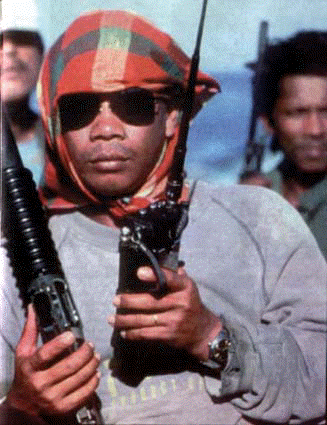
How do pirates do it?
There are essentially three types of pirate
attacks.
The most common type of attack is where
pirates board the merchant vessel, rob the crew and escape. These
raids on merchant crews are understood to yield an average US$20,000
haul. Considerable cash is commonly held in a merchant ship's safe
for payment port charges and payroll fees.
To quote the master of the freighter
M/V
Bonsella whose vessel was attacked by
26 Somali pirates off the northeastern tip of Somalia last year:
"I told them that we didn't
have any money, but the General of the Somali coastguard cocked
his pistol and pointed it by my head saying:
'Captain, no ship travels
without money. Do you really want to lose your life just as I
am about to set your ship free?"
(Slide 5 - to be added
)
That pirate highjacking lasted five days while
the M/V
Bonsella was used in several
unsuccessful attempts to board other vessels in the area. The problem
was the Bonsella was just too slow, for pirate work so its cargo of
first aid medicine was simply stripped from vessel, along with
everything else that could be carried off. At least the crew was
spared.
The second type of pirate attack is a more
ambitious one where pirates not only rob the crew but steal the
cargo. While simple robbery crimes normally employ pirate crews of 6
to 7 men, gangs of 70 or more may fall upon a merchant vessel when
it's cargo that they are after.
Unless the pirate gang is very sophisticated,
untraceable cargos are preferred such as timber, wire, metal &
minerals.
The time of attack is almost always between
1:00 a.m. and 6:00 a.m. During those hours, most of the crew is
either asleep, on the bridge or below decks in noisy engine spaces.
Little attention is paid to the sound of grappling hooks thrown over
the stern. Even a vessel making over 17 knots is not safe from expert
pirates who come along side at high speed and board in seconds.
Because vessels focus their attention and
look-outs forward for navigation ahead &emdash; pirates almost always
approach and board from the stern.
These can be pretty sophisticated thugs, using
radar and global positioning systems to track their prey. Modern
pirates have even been known to carry computer generated cargo
manifests which have been obtained in advance for later use during
machine gun enforced "shopping sprees."
But with profits from stolen cargo ranging
well into the millions of dollars per vessel, pirates can well afford
the luxuries of both new technology and proper planning. One favorite
scheme is for pirates to literally interview their intended victims
at port and then radio ahead to the pirate ship at sea when the time
for attack approaches.
A reverse of this scheme is the
"Pre-Planned Stowaway
Trick." It was showcased by the motor
tanker M/T Pulau
Mas which acted as a mother ship for
at least recent 21 recent pirate highjackings in Indonesian Seas.
These pirates perfected the technique of planting a phoney crew
member aboard the victim vessel who would then telephone to relay his
ship's position and route. The rendezvous would be deadly.
Another trick is a new twist on what I call
the "Little
Mermaid" concept. Pirates using
prostitutes for luring crews into what I would call "submission" so
that their vessel might be more easily attacked and taken.
The facts of each attack may be different, and
increasingly more innovative, but escape is always easy -- because
help for the merchant vessel is not "just around the corner."
Frequently the pirates even monitor communications so that further
punishment can be meted out to victims who might make a "May Day" or
distress call.
The terror experienced by lone victims at sea
is not an emotion we can readily understand.
Pirate gangs are generally thought to average
about 5 attacks a year, always retreating to the safety of a small
local port where they are often protected by the locals. Indeed,
piracy can be thought of as a cottage industry in areas of Indonesia
and the Philippines where agrarian pursuits alone may be insufficient
to support the local village economy. Indeed, it should be recalled
that the United States
Marine Corps. was originally formed to
battle the local pirates of Tripoli. History does repeat.
To
Top of Pirate Presentation
THE
PHANTOM SHIP
The third type of pirate attack is used to
create a "Phantom Ship." This is the most sophisticated
version of the crime, where pirates take literally everything
including the merchant vessel itself.
The pirate's first step is to locate a
suitable ship for use as the "Phantom."
As we have already discussed, pirates can
target and capture a ship, but another choice is to simply buy one
from another pirate.
Up until a few years ago, one could visit a
hotel overlooking Manila Bay and ask to see a pirate known as
"Capt. Changco." For a mere US$350,000.00 he would have a ship
seized for you and its crew thrown overboard on the high seas.
Fortunately, the good captain was caught and
executed.
Anyway, regardless of how your "Phantom Ship"
is acquired, the next steps are to repaint her, rename her and reflag
her &endash; it being very convenient to obtain temporary
registration through a registration office at either your local
Panamanian or Honduran Consulate. This month alone the Marshall
Islands has taken space in U.S, newspapers to announce "free
registration" for any ship until Jan. 1 2001. These "Blue Light
Specials" merely encourage crooks to become true pirates.
The next step is to find a shipper who is
short on time to move his cargo. An excellent victim candidate is
anyone with a letter of credit about to expire.
Next, the pirate gang or its bogus shipping
agent simply offers up the renamed "Phantom Ship" as carrier,
loads the cargo, issues an authentic looking bill of lading to the
proper destination port -- and sails off into the sunset.
Obviously, the Pirate diverts the "Phantom
Ship" to a different port, selling the cargo either to an
existing partner or an innocent buyer. Once its cargo is discharged
-- the time has come to again repaint, rename and reflag. What a
business!!
Although the most current figures available
are a couple years old, this "Phantom Ship" practice is
estimated to cost shippers at least US$200 million dollars a
year.
Last year was particularly brutal where these
practices are concerned. On September 25th armed Pirates boarded a
Malaysian tanker in Indonesian waters, horribly slashing one officer
and beating others before tying up the rest of the crew. They
repainted the ship's funnel and life boats &emdash; changed its name
and then rendezvoused with a second tanker for transferring the
ship's cargo. The attack cost a wholesale loss of
US$740,000.
In October the Japanese cargo ship
M/V Alondra
Rainbow was captured and had its 17
crew members set adrift on a raft.
In February the tanker M/T
Global Mars was captured by
Pirates and its crew set adrift for 13 days before being spotted off
the coast of Thailand.
Also in February the cargo
ship M/V
HUALIEN was taken off Taiwan, but its
21 crew haven't been seen since.
You never know for sure where the crews go.
When Chinese workers boarded the highjacked Australian
freighter M/V Erria
Inge a couple of years ago to cut it
up for scrap, they smelled something foul. Searching for the source,
they found ten members of the crew in a long unused refrigerator. The
bodies had been splashed with gasoline and burned alive by the
pirates who captured the vessel.
Speaking of gasoline & petroleum, these
substances have an even darker connection with the world of modern
piracy.
To
Top of Pirate Presentation
Awaiting
Enviromental Disaster
Some years ago, the world went wild over
consequences of M/T
Exxon Valdez having gone aground at
slow speed in Prince William sound in Alaskan waters. Our TV screen
were filled with scenes of marine pollution and environmental
damage.
On the other hand you probably don't even
know, that on 16 January 1999 the Very Large Crude Carrier
(VLCC) &endash; M/T
Chaumont was attacked by pirates while
underway in Philip Channel which is the narrowest part of the
Strait of
Malacca. Incredibly, the vessel
with her millions of gallons of oil steamed at full speed for over 70
minutes with no one on the bridge to in command. An environmental
disaster of epic proportions was avoided, but no one is quite sure
how. Likewise, no one is quite sure when this risk will next become a
terrible reality. But the "reality" can become "unimaginable" given
the right fuse to light. If M/T
Chaumont had been a liquified
natural gas carrier, an unimaginable event could become plausible
-- the equal of a hundred thousand tons of TNT exploding upon the
right collision conditions. Worse, imagine if a foreign power were to
manipulate pirates to undertake such a mission by design, such as
when the vessel is entering a port.
Given the increase in pirate activity -- true
environmental disaster is only a question of time. The clock is
ticking.
To
Top of Pirate Presentation
THERE'S
MORE PIRACY THAN YOU THINK
THE PROBLEM OF
UNDER-REPORTING
Having now hopefully now convinced you that
modern piracy is not only real, but a very real problem &endash;
please understand that there are far more international incidents
each year than anyone actually knows. The official reports mention
only a fraction of the problem. The problem is
under-reporting.
Ship owners are reluctant to either report or
directly address piracy for several reasons. The result is that only
10% are reported.
Ship owners are well aware that authorities
are unlikely to solve a particular crime. Indeed, there is often fear
that the authorities themselves are involved.
There is so very much money to be made that
pirate gangs have penetrated shipping companies, port authorities and
even customs services.
Under-reporting by the vessel interests can
also be explained in terms of wanting to avoid unfavorable media or
increased insurance premiums.
This said, ship owners mainly discourage
their Masters from filing piracy reports because it is a pocketbook
issue.
With daily vessel operating costs ranging from
US$10,000 to US$50,000 or more &endash; spending a week in Port while
untrained local police bumble through an investigation will usually
cost a lot more in lost time than the pirate attack itself. So unless
there is a murder or a vessel seizure the act of piracy may go
unreported.
No one really knows just how big a problem
piracy really is &endash; only that it is huge and growing. With some
90% going unreported, we are talking about thousands of unreported
attacks.
To
Top of Pirate Presentation
ANTI-PIRACY
EFFORTS
So what's being done to stem this bloody tide?
Well, as I've hopefully made clear &emdash; not nearly
enough.
Following the 1988 United Nations
"Rome Convention for
the Suppression of Unlawful Acts Against the Safety of Marine
Navigation," the 41 nations adopting
that treaty have only seen piracy increase.
The 1994
United Nations Law of the Sea Convention advanced
the concept of "Hot
Pursuit" whereby Naval units could
chase pirates into the territorial waters of other nations, capture
the pirates and then put them on trial at home all under one legal
jurisdiction. This is a good legal idea, but it is the Naval units
that are absent from the mix.
New laws just won't stop pirates &endash; this
can only be done with political will and naval power.
Fortunately, small steps have started to be
taken. The Philippine
Coast Guard has recently announced the
adding of 30 new vessels for patrol of its thousands of
archipelagoes.
For the first time in over 50 years, the
Japanese Maritime
Safety Force, has recently been
authorized to operate out of Singapore and is exercising this week
with Singapore forces on a specific Aniti-Piracy mission.
The Brazilian Congress has recently
established an anti-piracy force for Rio de Janero and hopes to
follow this shortly with a second unit at Port Santos.
To
Top of Pirate Presentation
PRIVATE
NAVIES
But it's the private efforts which are both
the most interesting -- and likely to be the most effective in the
short term.
For example, Somalia has recently established
a new "Maritime
Security Force," which will be run by
70 British "operatives" supplied by the Hart Group of Bermuda.
("Operative" is the politically correct term for
"mercenary.")
India has recently retained the services of a
Florida company known as "Special
Ops Associates" for use as an
anti-piracy force.
Meanwhile, 24 ship owners have retained the
unique services of a British company known as "Gurkha
International Manpower Services." That
company will supply you with teams of ex-British Gurkhas for cruise
line security and anti-piracy patrol services.
[Aside: By
"Gurkha",
we are not refering to those bottles of little green sweet
pickles! These are the quite fierce Ex-British Army troops that
have been the stuff of many movies. In making your personal list
of "THINGS NEVER TO
DO", tangling with a
Gurkha
would likely rank near #1.]
You may well expect this trend of hiring
"Private Navies" for combating piracy to continue.
To
Top of Pirate Presentation
The International
Maritime Bureau
But the private navies, public navies and
Gurkhas aside, there is one organization which has led the bitter,
bloody fight against piracy across the world's oceans &endash; for
the past 20 years --
Was it the
U.S.
Navy Seals?
How about the famous British
Special Boat Service?
No, when the going gets tough &endash; the
truly tough need to get going.
So when the chips are down -- who do you
call?
Well, the Chamber of Commerce of
course!
To be more specific, in 1981
the
International
Chamber of Commerce established
the London based "International
Maritime Bureau." The IMB is headed by
Eric Ellen who with a dedicated staff has led an almost single
handed war against piracy over the last 20 years. As a former Chief
Constable of the Port of London Police, Mr. Ellen's staff is the
central coordinating agency for reporting International Piracy.
In 1992, the IMB established a special
"Piracy
Reporting Center" under the
direction of Captain Pottengal Mukundan at Kuala Lumpur. Rapid
reporting by these agencies has been credited with many foiled piracy
attempts and multiple victim vessels recovered.
The IMB has moved forward to create a variety
of public and private programs designed to combat piracy. One program
about to be launched is the "Rapid Response Investigative Service."
Teams of trained anti-pirate investigators will move within hours to
complete criminal investigations often requiring many days on the
part of poorly trained port officials. The program is not only
designed to bring more of the criminals to justice, but also will
hopefully address the problem of under-reporting.
To
Top of Pirate Presentation
WHY NOT ARM
THE MERCHANT VESSELS?
So why can't we just forget about all the
reporting centers, Gurkhas and new laws &endash; and just arm the
merchant ships &endash; and blow these pirates away before they
board!!
The fact is &endash; most nations including
"Her Majesty" have placed an outright ban on arming merchant vessels
in order to avoid creating the "Wild
Wild West At Sea."
The fear is that use of guns by crew members
could easily escalate both the violence of these attacks and the
harshness of pirate reprisals. Worse, shooting the "wrong pirate"
could cause political, military or legal problems that are simply
impossible to solve. More, you can't even use a cell phone or
walkie-talkie on a tanker for fear for making a spark which might
explode the vessel, so imagine the problem of firearms!
No, guns seem to be out of the question even
though they are used to victimize hundreds of innocent merchant crew
every year.
This said, an effective brace of merchant
weapons are the fire hose, flare gun and ship's horn. Used together,
an alert crew can startle, blind and hose a pirate group off the deck
before an attack takes hold. The key here is robbing pirates of their
chief weapon &endash; the element of surprise.
(Slide 6 - to be added)
Diligence and better practices are starting to
make a difference:
Substitutes are being found for
carrying cash in the ship's safe;
24 hour radio watches;
Pre-charged fire hoses at the ready;
Anti-pirate watches have accounted for
dozens of repelled attacks this year alone; and
Bridge & engine room doors that will
not open from the outside create safe havens for crew members
against less determined pirate attacks.
On the technology side, all sorts of gadgets
have been proposed including a recent display in London of a bullet
proof life jacket!
One particularly effective system is known as
"Shiploc"
which uses a hidden personal computer aboard ship to monitor position
by satellite 24 hours a day. Should anyone breach a fiber optic
network stretched around the vessels perimeter, an automatic signal
is provided both to the ship's crew and authorities
ashore.
The ShipLoc System
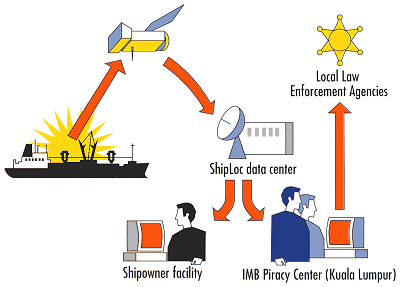
Visit the
ShipLoc
website
All 450 ships of "K"
Line have recently been equipped with
a similar system known as the "Seajack"
alarm.
Another competitor known as
"Tigers
Gate" immediately sounds an alarm for
alerting the crew to boarders.
To
Top of Pirate Presentation
Conclusion
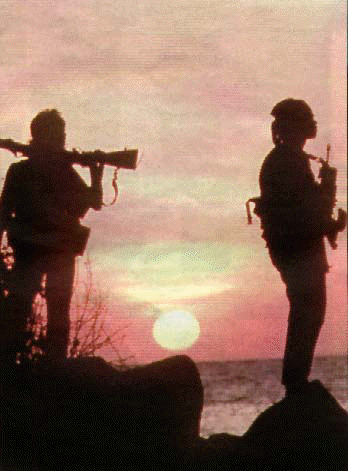
All this said -
Whatever the gun, gimmick, or Gurkha, it seems
clear that increased public awareness of modern high sea piracy is
going to be required before this deadly trend is truly
reversed.
I want to leave you with a recent statement on
this subject by Eric Ellen of the IMB:
"Even where the shoot 'em up TV
News is concerned, any highjacked plane whatsoever is considered
big news, but when a ship is taken forever, and its crew murdered
&endash; no one seems to care."
Now mates, you too have been told the pirate
tale.
Thank you for your attention to my
remarks.
2005 Modern
High Seas Piracy
Update
The world has taken surprisingly little notice
of "Modern High Seas
Piracy" since this presentation was
originally made before "The Propeller Club of the United States at
the Port of Chicago" in November 2000.
The International situation has grown far
worse each year according to the International Maritime
Bureau, which reported pirate attacks increased another by 20% in
2003 alone, rising to a total of 445 incidents compared to 370 in
2002. Over 21 seafarers are known to have been killed in the 2003
incidents, more than double the previous year. To this, add 71 crew
& passengers declared missing. While matters only worsened in
2004 , these figures do not take into account the much larger
number of incidents which did not occur in international waters --
nor which were not reported due to policies of certain shipping
companies --or which are due to terrorism. Other than becoming a
larger threat -- Modern
High Seas Piracy extends
it's tentacles -- into new, unexploited areas of maritime
commerce.
British-based International
Maritime Bureau said the number of pirate attacks worldwide in
the first nine months of the year fell to 205 - their lowest level in
6 years. This was an 18% drop from the 251 cases in the same period
last year -- largely due to increased anti-piracy efforts of
Maylaysia & Indonesia. But the measured drop in pirate acivity
neither took into account the growing pirate danger off Somalia --
nor the ferocity of attacks in that area.
Even when The
Cargo Letter reported dramatically
increased pirate acivity -- and
the seizure of
UN Food Program Aid
vessels -- off
the Somali Coast from March through
Oct. 2005 -- no notice was taken by the world of a worsening
maritime situation off Somalia. A very few examples
include:
The
Cargo Letter>>
PIRATE ATTACK>>
Maltese-registered
M/V
Pagania, South Africa for
Europe with iron ore -- 90 NM (167km) off Somali coast, near
Puntland region -- seized
by Somalia pirates --
demanded US$700,000 ransom
for her release. At least 23 hijackings & attempted
seizures recorded in the area since mid-March 2005, according
to the International Maritime Bureau (IMB). Time to do
something.
(Thurs. Oct. 20
2005)
The
Cargo Letter>>
ALERT -
Pirates
Take 2nd UN Aid Vessell>>
St Vincent & Grenadines-registered
M/V
Miltzow, with 10 crew --
offloaded 400 tons of the total 850-ton cargo of food aid in the
port of
Merka, 100km S. of
Mogadishu, when 6
armed pirates stormed ship & forced her to leave
port, the World Food
Program said. 2nd UN-chartered vessel carrying aid for
hunger-stricken Somalis was hijacked on Oct. 12 at a small port
south of Somalia's coast, becoming 4th ship to be seized in region
since June. Moments after seizure, Yusuf Indha Adde, the governor
of the Lower Shabelle region, immediately sent 2 boats to pursue
the vessel but there no reports of the outcome. Somalia has been
without a government since 1991. The
Int'l Maritime Bureau said
at least 22 attacks recorded off Somali coast since 15
March & urged ships in the area to stay as far as possible
from shore & keep to the minimum the use of radio
communication. (Wed. Oct. 12 2005)
UPDATE>>
Somali
pirates abandoned a UN-chartered food aid vessel they hijacked
earlier this week --
pirates left M/V
Miltzow just hours after
Somalia's transitional prime minister made urgent plea for foreign
warships to patrol coast & bring end to a surge in violent
attacks on commercial shipping in Somali waters. (Thurs. Oct. 13
2005) UPDATE>>
Hijackers
Oct. 14, released a U.N.-chartered
M/V
Miltzow
carrying food aid & crew of 10 following successful
negotiations with a Somali businessman. Not aware any ransom was
paid. (Fri. Oct. 14
2005)
The
Cargo Letter>>
Pirate Release
UPDATE>>
UN
World Food Program<<
Webfeature,
cargo M/V
Semlow --
hijacked
by Somali pirates in June has now been freed
-- all 8 Kenyan crew,
Tanzanian engineer & Sri Lankan Master reported all safe &
well by owner Motaku Shipping Agency. Hijackers have disembarked
& security people from El Maan port have embarked.
Ransom
paid?
Follow The Story.
(Mon. Oct. 3 2005)
Despite the dramatic loss of life and property
involved, the international press seems to have only discovered the
problem of Modern High
Seas Piracy for the first time on
Saturday, 5 November 2005 when a cruise ship joined the thousands of
victim vessels & crews.
The Cargo Letter issued the following
report:
PIRATE CRUISE SHIP
ATTACK>>
10,000gt luxury
440ft cruise
U.S.
owned
M/V
Seabourn Spirit<<
Webfeature,
on a 16-day cruise out of Alexandria in Egypt with 300 mostly
American & all terrified passengers for Kenyan port
city of Mombasa, narrowly
escaped seizure by gunmen 160km off pirate-infested Somali coast
--at least 2 boats closed in on the vessel & opened fire with
machine-guns &rocket-propelled grenades. M/V
Seabourn Spirit<<
Webfeature,
sped off to high seas at flank speed amid a trail of
gunfire --
Capt. made
distress call & later switched off radio communication to
avoid being traced by hijackers
-- gunmen sailing in 3 boats later abandoned chase as they could
not venture into high seas -- no one injured in botched hijack.
So stupid to sail these waters with paying passengers.
(Sat. Nov. 5, 2005) UPDATE>>
1
crewmember of M/V
Seabourn Spirit injured
by shrapnel during pirate attack.
(Sat. Nov. 5, 2005pm) UPDATE>>
Reports now put passenge manifest at 151 & 161 crew --
at least 3
rocket-propelled grenades hit ship, 1 in a passenger state room.
Vessel
expected to reach the
Seychellest<<
Webfeature,
on
Oct. 8, & then continue on previous schedule to
Singapore (Sun. Nov. 6, 2005)
UPDATE>>
unexploded
rocket ... is embedded
in some of passenger accommodation of the ship. (Mon. Nov. 7,
2005) UPDATE>>
M/V
Seabourn Spirit utilized
a new sonic device which SMASHED the attack, known as a
Long
Range Acoustic Device,
or
LRAD<<
Webfeature,
is a so-called "non-lethal weapon" developed for the military
after the 2000 attack on the USS
Cole<<
Webfeature,
in Yemen as a way to keep
operators of small boats from approaching U.S. warships. Makers of
the device compare its shrill tone to that of smoke detectors,
only much louder -- but directed with pinpoint accuracy. One
female passenger reported that she escaped injury because she was
taking a bath, and not in the ship's stateroom where an explosive
landed. (Mon. Nov. 7, 2005pm)
Update>>
Your
editor has given numerous interviews to the world press over this
M/V
Seabourn Spirit
incident in
the past 2 days . It is quite sad that the
VOICE
of The
Cargo Letter
should be heard only after a luxury cruise ship near miss --
there being so many merchant sailors who have been killed in
cold blood with no public notice in recent
years.
McD (Tues. Nov. 8,
2005pm)
Int'l
Maritme Bureau>>
CONTINUING ALERT
-- Somalia - NE & Eastern Coast --
"Twenty
five incidents have been reported since
15
March 2005.
Heavily armed pirates now attacking ships further away from
Somalia
coast.
Recent incident took place 120 nm off the eastern coast.
Ships advised
to keep as far away as possible from the Somali
coast."
>>> Despite these warnings,
operators
of
M/V
Seabourn Spirit<<
Webfeature,
Miami-based Seabourn
Cruise Line<<
Webfeature,
a subsidiary of Carnival
Corp -- deliberately
took her passengers into harms way. Not Our idea of a
pleaure cruise. (Sat. Nov. 5, 2005pm)
Armed pirate attack upon a cruise ship in
international waters was inevitable, and it is a sad commentary that
the world's attention has come only after so many merchant seamen
have been murdered in cold blood by past acts which few news agencies
cared to report. Inevitable, but avoidable -- as a wider berth to the
Somali Coast would have provided safety for the passengers &
crew. Still, we say Bravo Zulu to Seabourn
Cruise Line
for it's forward thinking defense
plans including fire hose deployment & use of the
Long
Range Acoustic Device,
or LRAD<<
Webfeature,
for anit-piracy use.
The
LRAD
vibrates your scull!
In a post-November 5, 2005 world &endash;
where attack on an American based cruise ship has captured both
public imagination and a spot on the evening news &endash; the urgent
question is whether these are true
pirates or whether terrorists are now
more in the mix. According to the classic
definition, if the motive is
financial gain, then it is piracy, but if it is political gain, then
it is terrorism. The distinction may now be blurred, but the risk
increases as emboldened pirates, Muslim separatists and operatives of
failed states are lured by Al Qaeda or other terrorist organizations.
We must recall that the November 2005 attack
on M/V
Seabourn Spirit is by no means the
first or worst cruise ship attack -- have we forgotten the deadly
1985 Palestine Liberation Front (PLF) terrorist attack on Italian
cruise M/V
Achille Lauro
where terrorist/pirate
mayhem included taking a crippled American Leon Klinghoffer -- in a
wheelchair -- and rolling him off the side of the ship to drown --
because he happened to be Jewish?
It may not be by coincidence alone that the
pirates who fell upon M/V
Seabourn Spirit on 5 November 2005 did
not appear equipped with grappling hooks for boarding the high decked
cruise vessel &endash;- only with machine guns &
rocket-propelled grenades for maximizing damage. It is definitely
the work of skilled prior planning that inflatable-ridged launches
could be conveniently loitering at a point of opportunity -- 100
miles off the Somali Coast. Modern
High Seas Piracy continues to evolve
and becomes more deadly. Many of the pirates are terrorists, bent on
Western destruction. As we speculated back in the original Year 2000
version of this presentation -- we spoke of vessels -- such as a
Liquified
Natural Gas Carrier which could be
used by pirates who were infliuenced by hostile nations to create an
unimaginable event -- suddenly made pausible by combining acient
intent with modern technology. In Year 2000, we only thought of other
nations being a threat -- but today many of those same pirates are
Al
Qaeda -- the world threat. We
think this may be the next 911.
Taken at random -- our weekly piracy reports
for the week of the M/V
Seabourn Spirit incident speaks
volumes as to the greater international problem of
Al
Qaeda . Below is posted our normal
Friday night pirate activity report. Nothing out of the ordinary here
-- just chaos & gunfire on the high seas.
WEEKLY
IMB
PIRATE
REPORTS ___
06 Nov.
2005 at 0648 UTC in position 02:29.3N - 048:28.2E, east coast
of Somalia. Pirates
armed with rocket launchers & machineguns fired upon RO/RO
ship underway.
Master took evasive maneuvers & increased speed to maximum.
Pirates' boats fell behind & ceased firing.
Bridge
windows damaged due to gunfire.
(Thurs. Nov. 10,
2005)
05 Nov. 2005
at 1200 UTC in position 04:26.3N - 054:14.6E, off east coast
Somalia. Bulk carrier underway spotted craft drifting 16nm
away. When ship came close, craft suddenly increased speed
& chased bulk carrier. Master took evasive maneuvers,
increased speed & moved away from coast. Pirate craft
continued chase until 1400 UTC before moving away. Craft had
one derrick -- master
suspects may be a mother ship to launch speedboats who attack
ships.
(Thurs. Nov. 10,
2005)
05 Nov. 2005,
around 0225 UTC, in position 02:59N - 048:01E, 70 nm from east
coast of Somalia. Six heavily armed pirates in 2 boats
chased cruise ship, M/V
Seabourn Spirit underway
--
fired with rocket launchers & machine guns causing damage
to ship's side. Master took evasive maneuvers & sailed away
from coast. Pirates aborted attempt & fled. One crew
sustained injuries to his hand.
(Thurs. Nov. 10,
2005)
31 Oct. 2005
at 1900 LT at Basrah oil terminal Alfa anchorage, Iraq --
pirates
armed with machine guns & knives boarded tanker
--
tied up 2 crew at forecastle & entered
accommodation. Then they
took 3 crew as hostage
& went to master's cabin &
fired
shots
at stairs. Robbers
ransacked master's cabin & escaped with ship's
safe.
(Thurs. Nov. 10,
2005)
30 Oct. 2005
at 0130 LT at Bahia del sol, El Salvador --
armed
pirates boarded yacht at anchor -- broke in to skipper's cabin.
Alarm raised & robbers jumped into water leaving behind 2
machetes.
Accomplice waiting in fishing boat picked them up.
Robbers
then fired gun shots at yacht before leaving
scene.
No injuries to crew. Incident reported to authorities who began
patroling anchorage during night. (Thurs.
Nov. 10, 2005)
I ask you to follow these stories each day --
as they happen at -- Daily
Int'l Vessel Casualties & Pirate Atttack Daily
Reports
Michael
S. McDaniel
Sadly, To Be Continued
........

The Law Offices of
Countryman & McDaniel
Eleventh Floor
LAX Airport Center
5933 West
Century Boulevard
Los Angeles,
California, 90045
(310) 342-6500
Voice
(310) 342-6505
Fax
 to
The Law Offices of Countryman &
McDaniel
to
The Law Offices of Countryman &
McDaniel
 to The Cargo
Letter
to The Cargo
Letter


 Back
To Main Page
Back
To Main Page








